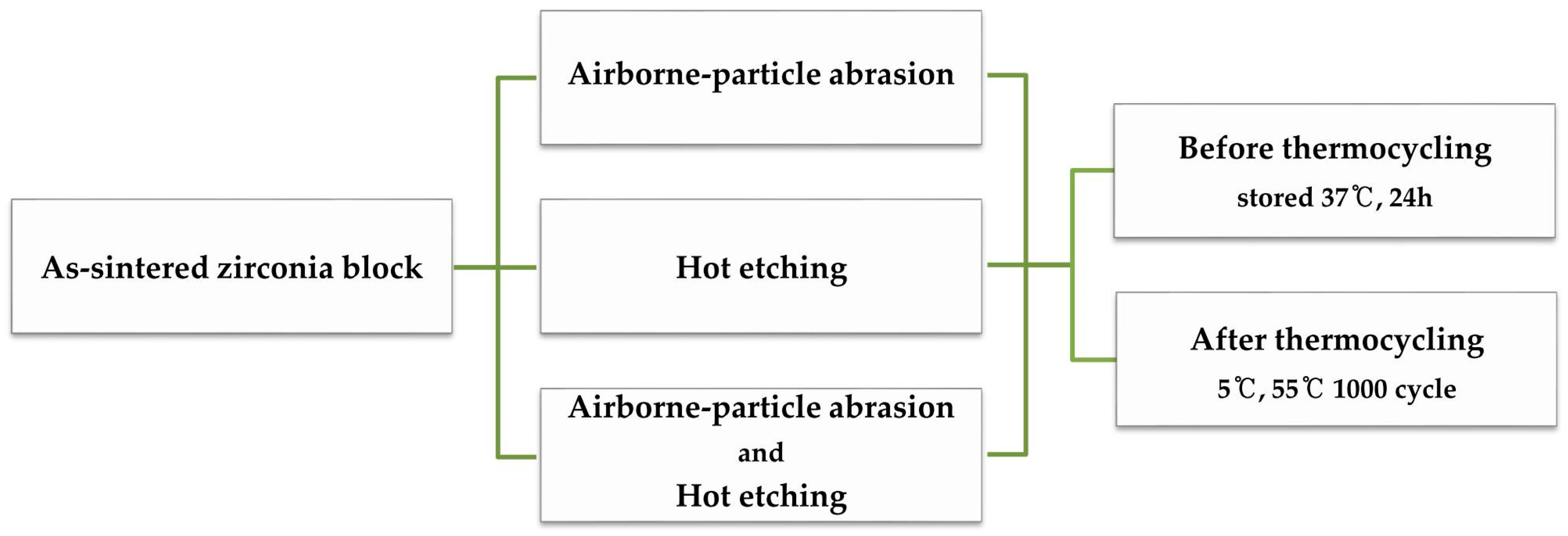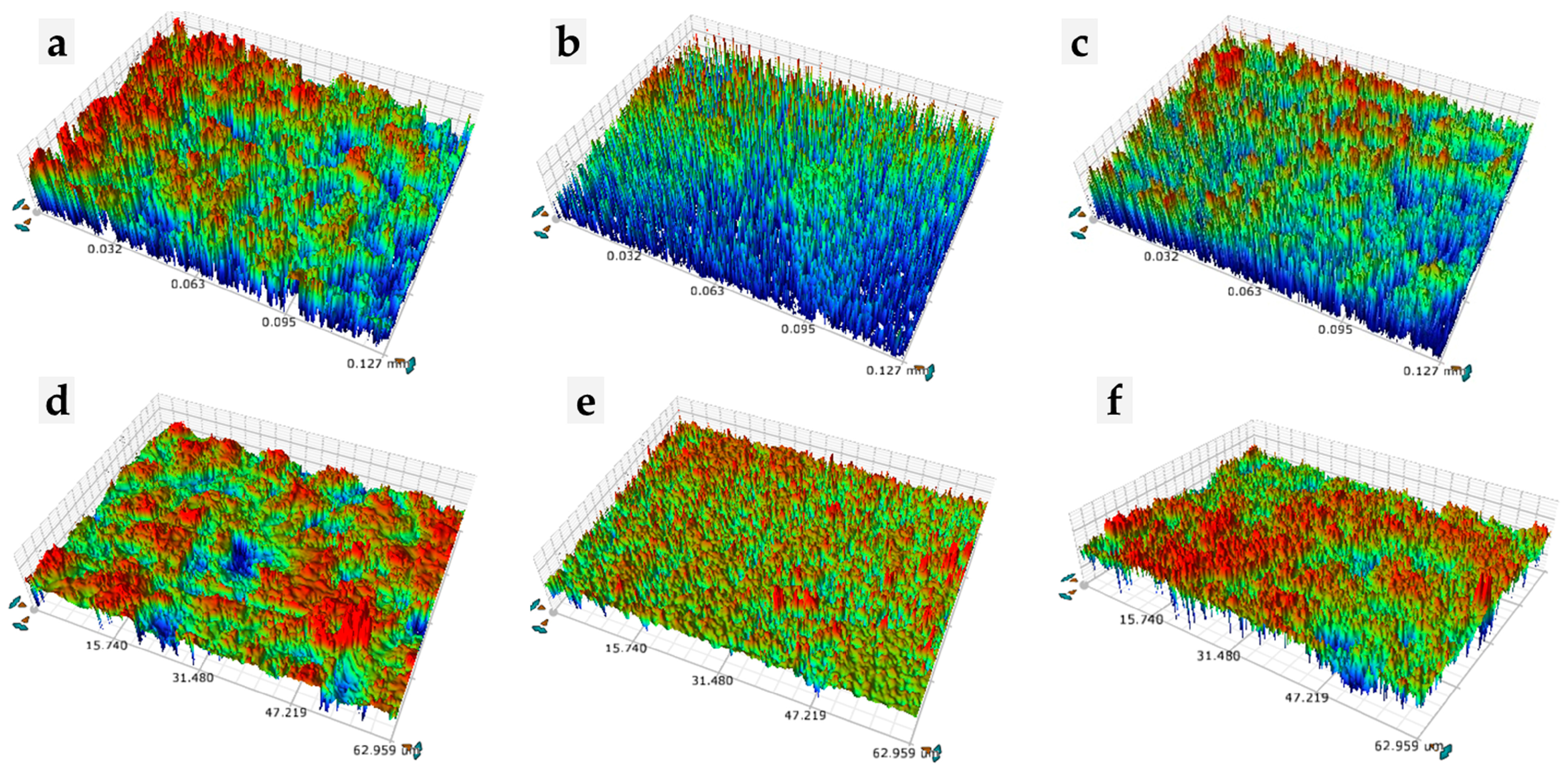Effect of Low-Concentration Hydrofluoric Acid Etching on Shear Bond Strength and Biaxial Flexural Strength after Thermocycling
Abstract
1. Introduction
2. Materials and Methods
2.1. Sample Preparation
2.2. Shear Bond Strength (SBS) Test
2.3. Biaxial Flexural Strength (BFS) Test
2.4. Scanning Electron Microscopy (SEM)
2.5. D Optical Microscopy
2.6. X-Ray Diffraction (XRD)
2.7. Statistical Analysis
3. Results
3.1. Shear Bond Strength (SBS)
3.2. Biaxial Flexural Strength (BFS)
3.3. X-Ray Diffraction (XRD)
3.4. Scanning Electron Microscopy (SEM)
3.5. Surface Roughness (Ra)
4. Discussion
5. Conclusions
Author Contributions
Acknowledgments
Conflicts of Interest
References
- Piconi, C.; Maccauro, G. Zirconia as a ceramic biomaterial. Biomaterials 1999, 20, 1–25. [Google Scholar] [CrossRef]
- Manicone, P.F.; Rossi Iommetti, P.; Raffaelli, L. An overview of zirconia ceramics: Basic properties and clinical applications. J. Dent. 2007, 35, 819–826. [Google Scholar] [CrossRef] [PubMed]
- Koutayas, S.O.; Vagkopoulou, T.; Pelekanos, S.; Koidis, P.; Strub, J.R. Zirconia in dentistry: Part 2. Evidence-based clinical breakthrough. Eur. J. Esthet. Dent. 2009, 4, 348–380. [Google Scholar] [PubMed]
- Casucci, A.; Osorio, E.; Osorio, R.; Monticelli, F.; Toledano, M.; Mazzitelli, C.; Ferrari, M. Influence of different surface treatments on surface zirconia frameworks. J. Dent. 2009, 37, 891–897. [Google Scholar] [CrossRef]
- Lv, P.; Yang, X.; Jiang, T. Influence of Hot-Etching Surface Treatment on Zirconia/Resin Shear Bond Strength. Materials (Basel) 2015, 8, 8087–8096. [Google Scholar] [CrossRef]
- Abdullah, A.O.; Hui, Y.; Sun, X.; Pollington, S.; Muhammed, F.K.; Liu, Y. Effects of different surface treatments on the shear bond strength of veneering ceramic materials to zirconia. J. Adv. Prosthodont. 2019, 11, 65–74. [Google Scholar] [CrossRef]
- Lee, J.H.; Lee, C.H. Effect of the Surface Treatment Method Using Airborne-Particle Abrasion and Hydrofluoric Acid on the Shear Bond Strength of Resin Cement to Zirconia. Dent. J. (Basel) 2017, 5, 23. [Google Scholar] [CrossRef]
- Tzanakakis, E.G.; Tzoutzas, I.G.; Koidis, P.T. Is there a potential for durable adhesion to zirconia restorations? A systematic review. J. Prosthet. Dent. 2016, 115, 9–19. [Google Scholar] [CrossRef]
- Dantas, A.M.; Campos, F.; Pereira, S.M.; Dos Santos, E.J.; Pereira, L.L.; Moura, D.M.; Souza, R.O. The effect of air-particle abrasion and a zirconia primer application on resin cement bonding strength to zirconia. Minerva Stomatol. 2019, 68, 89–94. [Google Scholar] [CrossRef]
- Yang, X.; Liu, Y. Influence of different surface treatments on zirconia/resin shear bond strength using one-bottle universal adhesive. Adv. Appl. Ceram. 2018, 118, 70–77. [Google Scholar] [CrossRef]
- Okada, M.; Taketa, H.; Torii, Y.; Irie, M.; Matsumoto, T. Optimal sandblasting conditions for conventional-type yttria-stabilized tetragonal zirconia polycrystals. Dent. Mater. 2019, 35, 169–175. [Google Scholar] [CrossRef] [PubMed]
- Inokoshi, M.; De Munck, J.; Minakuchi, S.; Van Meerbeek, B. Meta-analysis of bonding effectiveness to zirconia ceramics. J. Dent. Res. 2014, 93, 329–334. [Google Scholar] [CrossRef] [PubMed]
- Ozcan, M.; Bernasconi, M. Adhesion to zirconia used for dental restorations: A systematic review and meta-analysis. J. Adhes Dent. 2015, 17, 7–26. [Google Scholar] [PubMed]
- Wongkamhaeng, K.; Dawson, D.V.; Holloway, J.A.; Denry, I. Effect of Surface Modification on In-Depth Transformations and Flexural Strength of Zirconia Ceramics. J. Prosthodont. 2019, 28, e364–e375. [Google Scholar] [CrossRef] [PubMed]
- Okada, M.; Taketa, H.; Hara, E.S.; Torii, Y.; Irie, M.; Matsumoto, T. Improvement of mechanical properties of Y-TZP by thermal annealing with monoclinic zirconia nanoparticle coating. Dent. Mater. 2019, 35, 970–978. [Google Scholar] [CrossRef] [PubMed]
- Blatz, M.B.; Phark, J.H.; Ozer, F.; Mante, F.K.; Saleh, N.; Bergler, M.; Sadan, A. In vitro comparative bond strength of contemporary self-adhesive resin cements to zirconium oxide ceramic with and without air-particle abrasion. Clin. Oral Investig. 2010, 14, 187–192. [Google Scholar] [CrossRef]
- Kosmac, T.; Oblak, C.; Jevnikar, P.; Funduk, N.; Marion, L. The effect of surface grinding and sandblasting on flexural strength and reliability of Y-TZP zirconia ceramic. Dent. Mater. 1999, 15, 426–433. [Google Scholar] [CrossRef]
- Guazzato, M.; Quach, L.; Albakry, M.; Swain, M.V. Influence of surface and heat treatments on the flexural strength of Y-TZP dental ceramic. J. Dent. 2005, 33, 9–18. [Google Scholar] [CrossRef]
- Smielak, B.; Klimek, L. Effect of hydrofluoric acid concentration and etching duration on select surface roughness parameters for zirconia. J. Prosthet. Dent. 2015, 113, 596–602. [Google Scholar] [CrossRef]
- Guazzato, M.; Albakry, M.; Ringer, S.P.; Swain, M.V. Strength, fracture toughness and microstructure of a selection of all-ceramic materials. Part II. Zirconia-based dental ceramics. Dent. Mater. 2004, 20, 449–456. [Google Scholar] [CrossRef]
- Karakoca, S.; Yilmaz, H. Influence of surface treatments on surface roughness, phase transformation, and biaxial flexural strength of Y-TZP ceramics. J. Biomed. Mater. Res. B Appl. Biomater. 2009, 91, 930–937. [Google Scholar] [CrossRef] [PubMed]
- Sato, H.; Yamashita, D.; Ban, S. Structural change of zirconia surfaces by sandblasting and heat treatment. Dent. Mater. 2006, 25, 338–343. [Google Scholar]
- Xie, H.; Chen, C.; Dai, W.; Chen, G.; Zhang, F. In vitro short-term bonding performance of zirconia treated with hot acid etching and primer conditioning etching and primer conditioning. Dent. Mater. J. 2013, 32, 928–938. [Google Scholar] [CrossRef] [PubMed]
- Akyil, M.S.; Uzun, I.H.; Bayindir, F. Bond strength of resin cement to yttrium-stabilized tetragonal zirconia ceramic treated with air abrasion, silica coating, and laser irradiation. Photomed. Laser Surg. 2010, 28, 801–808. [Google Scholar] [CrossRef] [PubMed]
- Akin, H.; Ozkurt, Z.; Kirmali, O.; Kazazoglu, E.; Ozdemir, A.K. Shear bond strength of resin cement to zirconia ceramic after aluminum oxide sandblasting and various laser treatments. Photomed. Laser Surg. 2011, 29, 797–802. [Google Scholar] [CrossRef] [PubMed]
- Aboushelib, M.N.; Kleverlaan, C.J.; Feilzer, A.J. Selective infiltration-etching technique for a strong and durable bond of resin cements to zirconia-based materials. J. Prosthet. Dent. 2007, 98, 379–388. [Google Scholar] [CrossRef]
- Thompson, J.Y.; Stoner, B.R.; Piascik, J.R.; Smith, R. Adhesion/cementation to zirconia and other non-silicate ceramics: Where are we now? Dent. Mater. 2011, 27, 71–82. [Google Scholar] [CrossRef]
- Ural, C.; Kulunk, T.; Kulunk, S.; Kurt, M. The effect of laser treatment on bonding between zirconia ceramic surface and resin cement. Acta Odontol. Scand. 2010, 68, 354–359. [Google Scholar] [CrossRef]
- Della Bona, A.; Donassollo, T.A.; Demarco, F.F.; Barrett, A.A.; Mecholsky, J.J., Jr. Characterization and surface treatment effects on topography of a glass-infiltrated alumina/zirconia-reinforced ceramic. Dent. Mater. 2007, 23, 769–775. [Google Scholar] [CrossRef]
- Akay, C.; Cakirbay Tanis, M.; Sen, M. Effects of Hot Chemical Etching and 10-Metacryloxydecyl Dihydrogen Phosphate (MDP) Monomer on the Bond Strength of Zirconia Ceramics to Resin-Based Cements. J. Prosthodont. 2017, 26, 419–423. [Google Scholar] [CrossRef]
- Casucci, A.; Mazzitelli, C.; Monticelli, F.; Toledano, M.; Osorio, R.; Osorio, E.; Papacchini, F.; Ferrari, M. Morphological analysis of three zirconium oxide ceramics: Effect of surface treatments. Dent. Mater. 2010, 26, 751–760. [Google Scholar] [CrossRef] [PubMed]
- Casucci, A.; Monticelli, F.; Goracci, C.; Mazzitelli, C.; Cantoro, A.; Papacchini, F.; Ferrari, M. Effect of surface pre-treatments on the zirconia ceramic-resin cement microtensile bond strength. Dent. Mater. 2011, 27, 1024–1030. [Google Scholar] [CrossRef] [PubMed]
- Liu, D.; Tsoi, J.K.; Matinlinna, J.P.; Wong, H.M. Effects of some chemical surface modifications on resin zirconia adhesion. J. Mech. Behav. Biomed. Mater. 2015, 46, 23–30. [Google Scholar] [CrossRef] [PubMed]
- Sriamporn, T.; Thamrongananskul, N.; Busabok, C.; Poolthong, S.; Uo, M.; Tagami, J. Dental zirconia can be etched by hydrofluoric acid. Dent. Mater. J. 2014, 33, 79–85. [Google Scholar] [CrossRef] [PubMed]
- Alex, G. Preparing porcelain surfaces for optimal bonding. Compendium 2008, 29, 324, quiz 336. [Google Scholar]
- Garvie, R.C.; Nicholson, P.S. Phase Analysis in Zirconia Systems. J. Am. Ceram. Soc. 1972, 55, 303–305. [Google Scholar] [CrossRef]
- Toraya, H.; Yoshimura, M.; Somiya, S. Calibration Curve for Quantitative Analysis of the Monoclinic-Tetragonal ZrO2 System by X-Ray Diffraction. J. Am. Ceram. Soc. 1984, 67, C119–C121. [Google Scholar]
- De Oyague, R.C.; Monticelli, F.; Toledano, M.; Osorio, E.; Ferrari, M.; Osorio, R. Influence of surface treatments and resin cement selection on bonding to densely-sintered zirconium-oxide ceramic. Dent. Mater. 2009, 25, 172–179. [Google Scholar] [CrossRef]
- Aboushelib, M.N.; Feilzer, A.J.; Kleverlaan, C.J. Bonding to zirconia using a new surface treatment. J. Prosthodont. 2010, 19, 340–346. [Google Scholar] [CrossRef]
- Sato, H.; Yamada, K.; Pezzotti, G.; Nawa, M.; Ban, S. Mechanical properties of dental zirconia ceramics changed with sandblasting and heat treatment. Dent. Mater. J. 2008, 27, 408–414. [Google Scholar] [CrossRef]
- Blatz, M.B.; Sadan, A.; Kern, M. Resin-ceramic bonding: A review of the literature. J. Prosthet. Dent. 2003, 89, 268–274. [Google Scholar] [CrossRef] [PubMed]
- Subasi, M.G.; Demir, N.; Kara, O.; Ozturk, A.N.; Ozel, F. Mechanical properties of zirconia after different surface treatments and repeated firings. J. Adv. Prosthodont. 2014, 6, 462–467. [Google Scholar] [CrossRef] [PubMed]




| Material | Product Name | Main Composition a | Manufacturer |
|---|---|---|---|
| Zirconia block | D max Natura Z-W9812 | <95% ZrO2 + HfO2 <6% Y2O3 | DMAX Co., Daegu, Korea |
| Ceramic Primer | Z-Prime Primer | <90% Ethanol <10% Biphenyl dimethacrylate <20% 2-hydroxyethyl methacrylate (HEMA), <5% MDP | Bisco, Inc. Schaumburg, USA |
| Self-adhesive resin cement | TheraCem® | Base <50% Portland cement <50% Ytterbium w/ Barium Glass <5% Ytterbium Fluoride <5% BisGMA Catalyst paste <30% 10-Methacryloyloxydecyl Dihydrogen Phosphate, <5% 2-Hydroxyethyl Methacrylate | |
| Hydrofluoric acid | Zirconia Etchant | 9% Hydrofluoric acid gel <10% hydrofluoric acid <2% thickening agent | Medifive Co., Ltd., Korea |
| Surface Treatment | Group A | Group E | Group AE |
|---|---|---|---|
| Before thermocycling | 24.9 ± 3.0 a,A | 29.5 ± 2.9 b,A | 23.7 ± 3.1 a,A |
| After thermocycling | 11.4 ± 4.7 a,B | 15.5 ± 3.8 b,B | 11.5 ± 3.3 a,B |
| Surface Treatment | Group C | Group A | Group E | Group AE |
|---|---|---|---|---|
| Median (Q1–Q3) | ||||
| Before thermocycling | 1356.7 a,A (1324.6–1439.4) | 1412.8 a,A (1308.3–1452.3) | 1415.6 a,A (1371.3–1459.7) | 1416.0 a,A (1294.6–1538.7) |
| After Thermocycling | 1289.0 a,A (1044.1–1355.0) | 616.7 b,B (569.3–700.2) | 1048.8 a,A (960.9–1455.6) | 564.3 b,B (502.5–616.0) |
| Surface Treatment | Group C | Group A | Group E | Group AE |
|---|---|---|---|---|
| Before thermocycling | 1.6 ± 0.1 | 7.8 ± 0.2 | 2.6 ± 0.2 | 10.3 ± 0.5 |
| After thermocycling | 1.7 ± 0.1 | 8.4 ± 0.1 | 4.2 ± 0.8 | 9.5 ± 0.2 |
| Surface Treatment | Group A | Group E | Group AE |
|---|---|---|---|
| Before thermocycling | 0.439 ± 0.02 a,A | 0.247 ± 0.04 b,A | 0.428 ± 0.02 a,A |
| After thermocycling | 0.355 ± 0.02 a,B | 0.181 ± 0.01 b,B | 0.353 ± 0.01 a,B |
© 2020 by the authors. Licensee MDPI, Basel, Switzerland. This article is an open access article distributed under the terms and conditions of the Creative Commons Attribution (CC BY) license (http://creativecommons.org/licenses/by/4.0/).
Share and Cite
Kang, Y.-J.; Shin, Y.; Kim, J.-H. Effect of Low-Concentration Hydrofluoric Acid Etching on Shear Bond Strength and Biaxial Flexural Strength after Thermocycling. Materials 2020, 13, 1409. https://doi.org/10.3390/ma13061409
Kang Y-J, Shin Y, Kim J-H. Effect of Low-Concentration Hydrofluoric Acid Etching on Shear Bond Strength and Biaxial Flexural Strength after Thermocycling. Materials. 2020; 13(6):1409. https://doi.org/10.3390/ma13061409
Chicago/Turabian StyleKang, You-Jung, Yooseok Shin, and Jee-Hwan Kim. 2020. "Effect of Low-Concentration Hydrofluoric Acid Etching on Shear Bond Strength and Biaxial Flexural Strength after Thermocycling" Materials 13, no. 6: 1409. https://doi.org/10.3390/ma13061409
APA StyleKang, Y.-J., Shin, Y., & Kim, J.-H. (2020). Effect of Low-Concentration Hydrofluoric Acid Etching on Shear Bond Strength and Biaxial Flexural Strength after Thermocycling. Materials, 13(6), 1409. https://doi.org/10.3390/ma13061409






